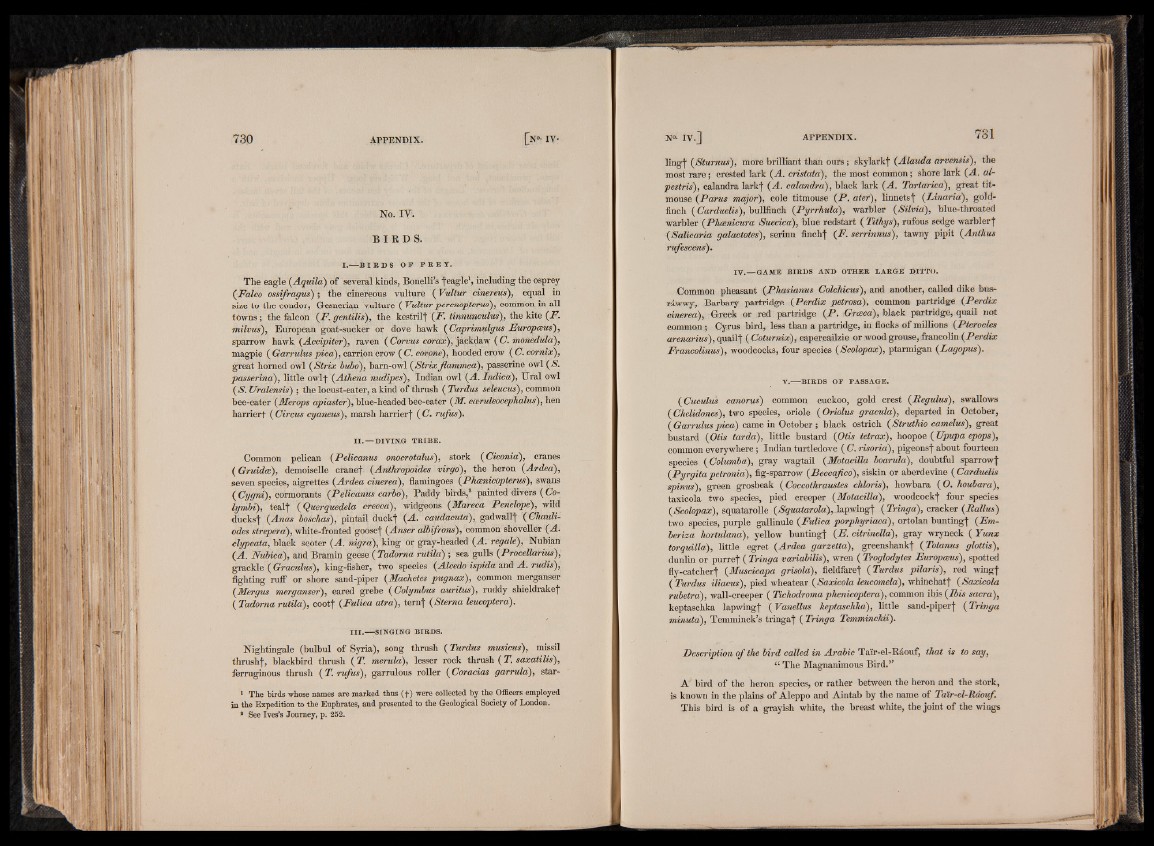
No. IV.
BIRDS.
I . B I E D S O P P R E Y .
The eagle (Aquila) of several kinds, Bonelli’s feagle1, including the osprey
{Falco ossifragus) ; the cinereous vulture ( Vultur cinereus), equal in
size to the condor, Gesnerian vulture ( Vultur percnopterus), common in all
towns ; the falcon {F. gentilis), the kestrilj- (F. tinnunculus), the kite (F .
milvus), European goat-sueker or dove hawk ( Caprimulgus Ewropmus),
sparrow hawk (Accipiter), raven ( Corvus corax), jackdaw ( C. monedula),
magpie ( Garrulus pica), carrion crow ( C. corone), hooded crow {C. cor nix),
great horned owl ( S trix bubo), barn-owl ( S trix flammea), passerine owl {S.
passerina), little owlf {Athena nudipes), Indian owl {A. Indica), Ural owl
(S . Uralensis) ; the locust-eater, a kind of thrush ( Turdus seleucus), common
bee-eater {Merops apiaster), blue-headed bée-eater {M. cceruleocejihalus), hen
harrierf ( Circus cyaneus), marsh harrierj ( C. rufus).
I I . — DIVIN,G TR IB E .
Common pelican {Pelicanus onocrotalus), stork {Ciconia), cranes
( Gruidat), demoiselle cranef (Anthropoides virgo), the heron (Ardea),
seven species, aigrettes (Ardea cinerea), flamingoes (Phanicopterus), swans
{Cygni), cormorants {Pelicanus carbo), Paddy birds,8 painted divers ( Co-
lymbi), ten It ( Querquedela crecca), widgeons (Mareca Penelope), wild
ducksj" {Anas boschas), pintail duck t {A. caudàcuta), gad wall j {Chauli-
odes streperà), white-fronted goósej {Anser albifrons), Common shoveller {A.
clypeata, black scoter {A. nigra), king or gray-headed {A. regale), Nubian
{A . Nubica), and Bramin geese ( Tadorna rutila) ; sea gulls (Procellarius),
grackle ( Graculus), king-fisher, two species {Alcedo ispida and A . rudis),
fighting ruflT or shore sand-piper {Machetes pugnax), common merganser
(fliergus merganser), eared grebe {Colymbus auritus), ruddy shieldrakcj
{Tadorna rutila), cootf {Fulica atra), ternf {Sterna leucoptera).
I I I . SINGING BIRDS.
Nightingale (bulbul of Syria), song thrush ( Turdus musicus), missil
thrushf, blackbird thrush ( T. merula), lesser rock thrush ( T. saxatilis),
ferruginous thrush {T. rufus), garrulous roller {Coracias garrula), star-
1 The birds whose names are marked thus (f) were collected by the Officers employed
in the Expedition to the Euphrates, and presented to the Geological Society of London.
1 See Ives’s Journey, p. 252.
-i Cf o 1
N°- IV .J APPEND IX. ¡OL
lingj- {Sturnus), more brilliant than ours; skylarkj {Alauda arvensis), the
most ra r e ; crested lark {A. cristata), the most common; shore lark {A. al-
pestris), calandra larkj (A . calandra), black lark (A . Tartarica), great titmouse
(P o r ta major), cole titmouse {P .a te r), linnetsj {Linaria), goldfinch
{Carduelis), bullfinch {Pyrrhula), warbler {Silvia), blue-throated
warbler {Phcenicura Suecica), blue redstart ( Titkys), rufous sedge warblerf
{Salicaria galactotes), serinn finchf (P . serrinnus), tawny pipit {Anthus
rufescens).
iv .—game birds and other large p rr fo .
Common pheasant (Phasianus Calchicus), and another, called dike bus-
rawwy, Barbary partridge {Perdix petrosa), common partridge {Perdix
cinerea), Greek or red partridge (P . Grceca), black partridge, quail not
eommon; Cyrus bird, less than a partridge, in flocks of millions {Pterocles
arenarius), quailf { Cotumix), capercailzie or wood grouse, francolin ( P erdix
Francolinus), woodcocks, four species {Scolopax), ptarmigan {Lagopus).
V. BIRDS OF PASSAGE.
( Cuculus canorus) common cuckoo, gold crest {Begulus), swallows
{Chelidones), two species, oriole {Oriolus gracula), departed in October,
( Garrulus pica) came in October; black ostrich {Struthio camelus), great
bustard {Otis tarda), little bustard {Otis tetrax), hoopoe ( Upupa epops),
common everywhere; Indian turtledove {C.risoria), pigeons j about fourteen
species ( Columba), gray wagtail {Motacilla boarula), doubtful sparrowf
{Pyrgitapetronia), fig-sparrow {Beccafico), siskin or aberdevine {Carduelis
spinus), green grosbeak {Coccothraustes chloris), howbara (O. houbara),
taxicola two species, pied creeper {Motacilla), woodcockf four species
{Scolopax), squatarolle {Squatarola), lapwing) {Tringa), cracker {Ballus)
two species, purple gallinule {Fulica porphyriaca), ortolan buntingf {Em-
beriza hortulana), yellow buntingf {E. citrinella), gray wryneck ( Y u n x
torquilla), little egret {Ardea garzetta), greenshankf {Totanus glottis),
dunlin or purref ( Tringa variabilis), wren ( Troglodytes Europeeus), spotted
fly-catcherj- {Muscicapa grisola), fieldfarej {Turdus pilaris), red wingf
{Turdus iliacus), pied wheatear {Saxicola leucomela), whinchatf {Saxicola
rubetra), wall-creeper ( Tichodroma phenicoptera), common ibis {Ibis sacra),
keptaschka lapwingf ( Vanellus keptaschka), little sand-piperj ( Tringa
minuta), Temminck’s tringaj ( Tringa Temminckii).
Description o f the bird called in Arabic Ta'ir-el-Rdouf, that is to say,
“ The Magnanimous Bird.”
A bird of the heron species, or rather between the heron and the stork,
is known in the plains of Aleppo and Aintab by the name of Tair-el-Raouf.
This bird is of a grayish white, the breast white, the joint of the wings